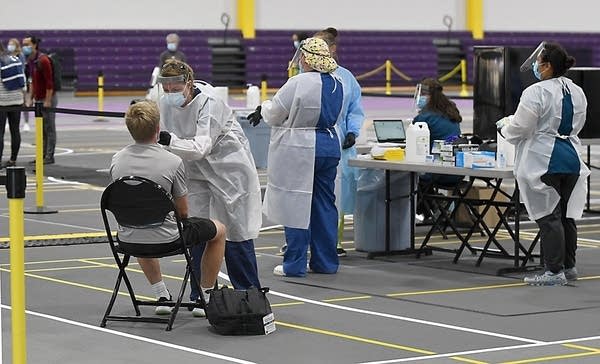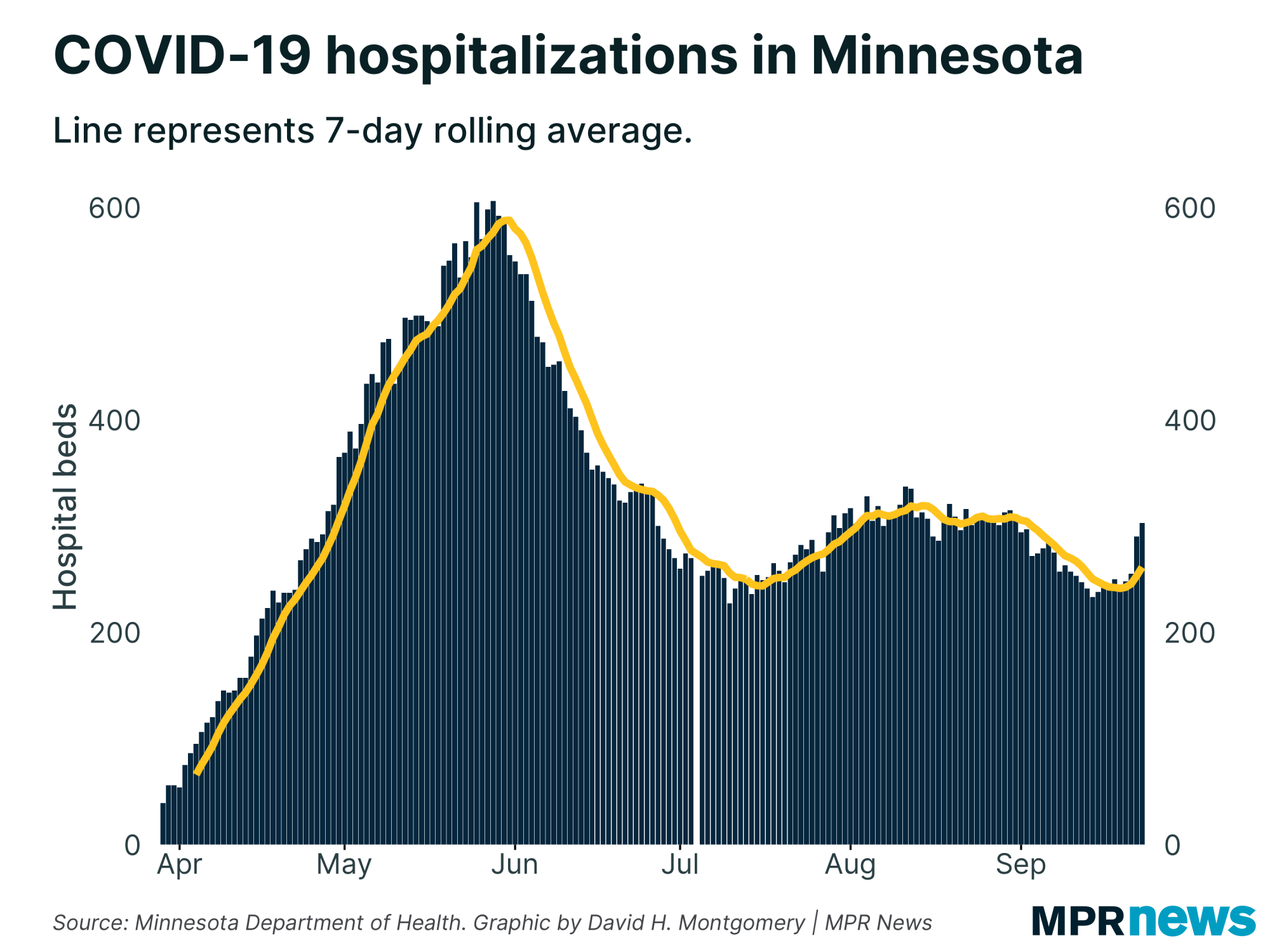Sept. 7 update on COVID-19 in MN: 638 new cases, 3 more deaths

Go Deeper.
Create an account or log in to save stories.
Like this?
Thanks for liking this story! We have added it to a list of your favorite stories.
Updated: 11:35 a.m.
State health officials on Monday confirmed another 638 cases of COVID-19 in Minnesota, adding to the count of more than 1,600 from the first two days of the Labor Day holiday weekend, pushing the total number of cases above 81,000 since the pandemic began.
The data remained in a familiar pattern — daily deaths stayed in the single digits and hospitalizations dipped, but new cases continued to grow.
While the latest reported cases aren’t related to Labor Day weekend gatherings, the relatively high numbers of new cases in recent days prompted state officials to issue pleas last week to keep following pandemic safety guidelines over the holiday.

About one-third of new cases are now coming from community spread of unknown origin — higher than just before the Fourth of July, the last major holiday that brought Minnesotans together.
Turn Up Your Support
MPR News helps you turn down the noise and build shared understanding. Turn up your support for this public resource and keep trusted journalism accessible to all.

“We’re in a more precarious situation today” compared to then, Health Commissioner Jan Malcolm said last week. “There is risk in this situation. The virus is all over the state. The outbreaks are happening all over the state … and we just want people to be vigilant.”
Here are Minnesota’s latest COVID-19 statistics:
1,860 deaths (three new)
81,225 positive cases (638 new); 73,403 off isolation
275 currently hospitalized; 136 in ICU
1,609,618 tests; 1,197,675 people tested
Officials said last week that they believe too many Minnesotans have numbed to the need to stay vigilant in the pandemic, opening the door to more spread that can’t easily be traced. They’re worried informal Labor Day holiday gatherings of family and friends will accelerate the trend.
Minnesota currently has more than 6,000 active, confirmed cases, a record in the outbreak, although the number (confirmed and unconfirmed) was likely higher in May when testing was much lower.

With newly confirmed cases rising steeply the past few weeks and college students and kids returning to school, young adults are a particular concern.
People in their 20s make up the age bracket with the state’s largest number of confirmed cases — nearly 19,000 since the pandemic began, including nearly 11,000 among people ages 20-24.

They are driving the current outbreaks, although the number of high school-age children confirmed with the disease has also grown recently, topping 7,000 total cases for children 15 to 19 years old since the pandemic began.
While less likely to feel the worst effects of the disease, experts worry youth and young adults will spread it to grandparents and other vulnerable populations and that such outbreaks could cripple attempts to reopen campuses completely to in-person teaching.
Health authorities noted a spike in Winona County they attribute to college-age people returning to schools there. Winona State University and St. Mary's University are based in Winona. The city also has a Minnesota State College Southeast campus.
Cases are rising most quickly now in west-central Minnesota, including Stevens County, which has seen its cases double in the last nine days from 38 to 78.

While southern Minnesota and the Twin Cities suburbs continue to drive new case confirmations, central and northern Minnesota are also on the rise.

State health authorities have said backyard parties, get-togethers to start the new school year and other casual meetups are fueling the current case counts.
Minnesotans’ behavior in stores, restaurants and other public places isn’t so much the problem now, but “informal gatherings have really proven to be a weak spot in our response to the pandemic,” Malcolm said last week.
Developments around the state
Demand for food banks expected to soar with onset of winter
Food shelves are expecting to see unprecedented demand this winter, due to the economic impact of COVID-19.
Allison O'Toole, CEO of Second Harvest Heartland, said the current demand for food aid is unlike anything the country has seen since the Great Depression and while the region is in the middle of an unprecendented surge in hunger amid the pandemic, it has yet to reach its peak.
"That means moms and dads are skipping meals so their kids can have more. That means families are watering down milk. That means people are turning ketchup packets into meals,” O’Toole said.
O'Toole added that her organization is delivering 300,000 pounds of food daily to food shelves in Minnesota and western Wisconsin — that's double the amount it was delivering at this time last year. O'Toole said she expects the demand to continue to increase with the onset of winter.
Despite reports of unprecendented need for food aid in Minnesota, some rural food shelves say they are seeing a decline in clientele in their area.
Alana Ziehl, executive director of the Kandiyohi County Food Shelf, attributes the decline in part to the Supplemental Nutrition Assistance Program, or SNAP. She said the federal aid program has increased its allotments to qualifying households during the pandemic. SNAP benefits are being extended on a month-by-month basis.
So they aren't needing us as much right now. But when and if that does go away, that's when we're going to be seeing the huge increase of need," she said.
Ziehl added that rural food shelves need cash assistance in order to purchase supplies from food banks so they can meet the demand.
“Even pre-COVID, there's a lot of people that are living paycheck to paycheck, you know, one in a house, a single mom with three kids not getting child support, anything like that,” Ziehl said. “They're coming to us for help; any little bit of help they can get to help them pay a fuel bill or gas in their car to get to their their job, that kind of thing."
One in 8 Minnesotans is expected to face hunger in the coming months with more than a third of them being children, according to a study commissioned by Second Harvest Heartland.
— Marianne Combs | MPR News
Walz to request extension of emergency powers
The emergency footing Minnesota has been on since March is likely to be extended at least one more month.
Gov. Tim Walz first declared a peacetime emergency in March when the coronavirus was detected in Minnesota. He’s renewed it five times since. Walz has until Friday to reup the order, which he has given every indication he will do.
The duration of the emergency is unprecedented in modern times. It's drawn scorn from Republicans who argue it has cut the Legislature out of decision-making. They say the COVID-19 situation has stabilized enough for the executive powers to lapse.
Walz said the pandemic is still flaring and his administration needs flexibility to procure supplies, direct agency resources and expedite aid.
The law compels the governor to call the Legislature into special session upon each extension. Both the House and Senate would have to vote in favor of any move to rescind the powers, an unlikely outcome given divided party control.
— Brian Bakst | MPR News
Top headlines
Minnesota Supreme Court expected to expedite voter-aid case: Justices will decide if a pair of laws covering the level of assistance permitted for voters will remain active or be suspended. A lower court halted enforcement. The case is one in a sprawling battle over the way the 2020 election will be conducted.
COVID-19 looms over sugarbeet harvest: Sugarbeet growers and processors hire thousands of workers each year of the harvest. This year they need to protect them from COVID-19 to ensure the harvest is brought in.
At least 12 states report coronavirus cases linked to Sturgis rally: More than two weeks after nearly half a million bikers flocked to South Dakota, the tally of coronavirus infections traced back to the Sturgis Motorcycle Rally has surpassed 260, an estimate that is growing steadily as more states report cases, with the first known COVID-19 death of an attendee reported in Minnesota.
COVID-19 in Minnesota
Data in these graphs are based on the Minnesota Department of Health's cumulative totals released at 11 a.m. daily. You can find more detailed statistics on COVID-19 at the Health Department website.


